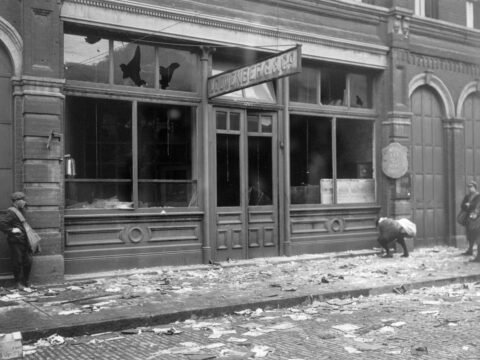Complicating The Home Front
by Aron BrownVisual and textual resources help bring to light the experiences of German Canadians in British Columbia during the Great War. Violence and Discrimination played off of major world events and propaganda, as people of German ancestry within British Columbia faced prejudice for events that took place a world away.

By Aron Brown
Along with the German consulate, the German club above the Dominion Express office was vandalized after the sinking of the SS Lusitania by a German U-Boat. The SS Lusitania had a high proportion of British and Canadian passengers when it sank, and was carrying war munitions on board as well.

1In 1 playlists
By Aron Brown
Damage to the German consulate in Victoria after the sinking of the SS Lusitania. The RMS Lusitania was a British ocean liner which was sunk 18 kilometers off the south coast of Ireland by a German U-Boat.

By Aron Brown
The Kaiserhof hotel in Victoria was damaged by anti-German rioters after the sinking of the SS Lusitania. This demonstration took place May 8th 1915.

1In 1 playlists
By Aron Brown
This photo captures a large subset of demonstrators who engaged in the anti-German riots on German owned businesses following the sinking of the SS Lusitania. The demonstrators are pictured outside the Kaiserhof Hotel on May 8th, 1915.

1In 1 playlists
By Aron Brown
"Once a German - Always a German!" An anti German propaganda poster created by the United Kingdom in January of 1918. The poster draws upon anti German sentiment, and wartime German stereotypes to encourage citizens not to buy German goods or hire German workers.
The poster was taken from the "Canadian Museum of History." Source
The poster was taken from the "Canadian Museum of History." Source

1In 1 playlists
By Aron Brown
Enacted in August 1914, the War Measures Act allowed the Canadian government to suspend and restrain civil autonomy to those who were perceived a threat during times of war. This included "enemy aliens," many of which were of German and Ukrainian ancestry.

1In 1 playlists
By Aron Brown
In the image we see a profile of an internment camp in Vernon, B.C. during WW1 for Germanic and Austro-Hungarian prisoners of war. These camps were set up as a way of dealing with "enemy aliens" who were thought as posing a danger to Canada through espionage and sabotage.

1In 1 playlists
By Aron Brown
Men, Women, and children were interned at many of these camps during WW1. Here we have an image of two children at an internment camp in Vernon, B.C. On the photograph is written "Some happy camp children." Who might be taking the photo? Could the photo be staged?

1In 1 playlists
By Aron Brown
Internment camp at Morrissey B.C. during WW1 for Germanic and Austro-Hungarian people. How does this image contrast the other two images of internment camps in Vernon? What might you be able to tell about living conditions from the photo?

1In 1 playlists
By Aron Brown
Addressed to Nykolay Andrusiak, a subject of Austria, is a certificate of release from an internment camp at Vernon, B.C. As we can see in the conditions of discharge, Nykolay's conditions reflect many of the sections of the War Measures Act of 1914.
Taken from Library and Archives Canada. MIKAN no. 1604479
Taken from Library and Archives Canada. MIKAN no. 1604479

By Aron Brown
Bill C-331 passed in 2005 acknowledges the internment of peoples of Ukrainian origin during WW1 under the authority of Parliament. The enactment represents negotiations between Ukrainian-Canadian organisations and the Government to enact measures that recognize the internment of Ukrainian peoples during WW1.

7In 7 playlists
Documentary film and photographic images held in the BC Archives help us to remember the First World War. Watch video, see photographs and read about the war sometimes called The Great War.
View Pathway